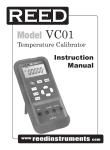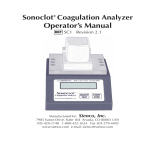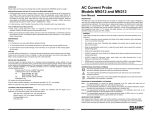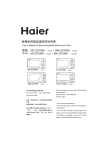Download SGA21 Manual - Tension Measurement, inc.
Transcript
Analog Strain Signal Conditioner SGA21 / SGA21-2S User Manual Tension Measurement, Inc. P.O. Box 740755, Arvada, CO 80006-0755 USA Web: www.tension-measurement.com Ph: (303)465-1011 Fax: (303)466-9761 Email: [email protected] Page 1/8 1. Introduction The SGA21 device is an analog sensor conditioner. It is mainly used with strain gage sensors such as load cells, torque sensors or pressure sensors. The SGA21-2S version includes 2 adjustable set points. 2. Presentation SGA21-1, Board model SGA21, DIN rail model SGA21-3, IP65 Housing model 3. General specifications 24+/-4 0.05 VDC Overall accuracy Zero temperature drift <0.035 %/°C (FS*) Span temperature drift <0.02 %/°C (FS*) 0…+70 °C Power supply Operating temperature range Sensor supply voltage (jumper selection) Min. sensor impedance - voltage 3, 5V - voltage 10V Span adjustment Max. supply current SGA21/SGA21-2S 3, 5, 10 80 160 0.15 … 12 120/170 % V Ω mV/V mA +/-10, 0-10 4-20 mA Load impedance (Voltage output) >2000 Ω Load impedance (Current output) <500 <1 10 20 Voltage output Current output Output capacitive load Filter (jumper selection) Bandwidth (up to) V Ω nF Hz KHz *FS = Full Scale Page 2/8 4. Wiring and setting devices positioning 4/6 wire sensor selection 4.1 & 5 Sensor supply voltage selection 4.2 & 5 ‘Cal’ push button 4.8 2 3 4 5 6 7 3V 5V 10V 1 8 9 10 11 12 Power supply led Sensor connection 4.1 & 5 P2 Zero adjustment 4.6 P3 Power supply and output signal connection 4.3 Sensor sensitivity selection 4.5 P1 Span adjustment 4.7 Filtering selection 4.4 4.1 Sensor connections The SGA21 is able to manage up to 4 load cells (350Ω) connected in parallel through a junction box (Excitaiton jumper must be set to 5VDC or 3VDC for 4 load cell systems). • Sensor connection 4 wire sensor. The two jumpers stay in place. 6 wire sensor. The two jumpers are removed. Gnd 7 Gnd 6 Sens - Ref- 6 Sens - 5 Sens + Ref+ 5 Sens + Ex+ 4 Ex + Sig- 3 Sig Sig + Ex - 7 4 wire sensor Ex+ 4 Ex + Sig- 3 Sig - 6 wire sensor Sig+ 2 Sig + Sig+ 2 Ex- 1 Ex - Ex- 1 2 jumpers removed 2 jumpers set in place 4.2 Sensor supply voltage Set the jumper in position corresponding to the selected voltage : 3VDC, 5VDC or 10VDC. The load cells are generally supplied in 5V (default value). 3V voltage is useful for some particular sensors, 10V is recommended for low sensitivity (or low output signal) sensors. Warning : With 10VDC supply voltage, only 2 load cells (350 Ω) can be connected. For load cells used in ATEX area and protected by Zener barriers, do not use 10V supply voltage. Page 3/8 4.3 Power supply and analog outputs Power supply 24VDC±4 Current analog output 4/20mA 12 + 24V 11 Gnd 10 Gnd 9 Iout 8 Vout Voltage analog output 0/10V or +/-10V 4/20mA current analog output and 0/10V voltage analog output can be used simultaneously. The ‘Gnd’ points are internally connected in the circuit board. 4.4 Sensor signal filtering The filter is a second order low-pass type with 10Hz cutting frequency. The filter is generally used to eliminate troubles caused by vibrations of the installation. If a faster response time is necessary, it’s recommended to disable the filter. • Enable filtering : without filter filter Jumper to set filter 4.5 Sensor sensitivity selection To get the correct signal on the analog output (0/10V or 4/20mA), set the sensor sensitivity jumper according to the following table: Note : The load cell sensitivity is indicated on the quality control sheet attached with the load cell. • Positionning of configuration jumper 1 2 3 4 5 6 7 8 9 Sensor sensitivity (mV/V) Jumper position Sensor power supply 3V Sensor power supply 10V Sensor power supply 5V 0.50 Æ 0.66 0.15 Æ 0.20 0.30 Æ 0.40 X 0.66 Æ 0.93 0.20 Æ 0.28 0.40 Æ 0.56 1 0.93 Æ 1.30 0.28 Æ 0.39 0.56 Æ 0.78 2 1.30 Æ 1.80 0.39 Æ 0.54 0.78 Æ 1.08 3 1.80 Æ 2.50 0.54 Æ 0.75 1.08 Æ 1.50 4 2.50 Æ 3.40 0.75 Æ 1.02 1.50 Æ 2.05 5 3.40 Æ 4.65 1.02 Æ 1.40 2.05 Æ 2.80 6 4.65 Æ 6.50 1.40 Æ 1.95 2.80 Æ 3.90 7 6.50 Æ 8.80 1.95 Æ 2.65 3.90 Æ 5.30 8 8.80 Æ 12.50 2.65 Æ 3.75 5.30 Æ 7.50 9 Example Load cell with 500kg capacity and 2mV/V sensitivity. Load cell supply voltage : 5V Maximum load to be measured : 200kg for 10V Sensitivity for a 200kg load = (200kg/500kg) x 2mV/V = 0.8mV/V For X position, put the jumper between 8 and 9. Position 1 1 2 3 4 5 6 7 8 9 The jumper will be set in position number 3 Position X Page 4/8 4.6 Zero adjustment • Verify that no load (except the load receptor) is applied on the load cell. • Approach the zero with P2 potentiometer and make a fine adjustment with P3 potentiometer. - Analog output 0/10V : voltmeter displays 0V. - Analog output 4/20mA : ampere meter displays 4mA. 4.7 Span adjustment • After zero adjustment, apply a known load on the load cell. • Adjust span with P1 potentiometer until the analog output signal complies with the applied load. Example : If the applied load is the maximum load, adjust P1 until output signal is 10V or 20mA. If the applied load is not the max. load. For example, with a 200kg load cell and only a 100kg load available for the adjustment : Adjust P1 to obtain : 10V x (100kg / 200kg) = 5V (or 12mA) • Remove the load and verify the zero adjustment. If necessary, make a new zero adjustment followed by a new span adjustment. 4.8 Shunt calibration / control If the load cell specifications are known : - Output resistance (Z) and Sensitivity (S). It is not necessary to put a calibrated weight on the load cell for span adjustment. You just have to : 1. Connect the load cell 2. Select the load cell sensitivity (4.5) 3. Adjust the zero (4.6) Then : 4. While maintaining pressure on the push button ‘Cal’, adjust the output voltage (or current) with P1 potentiometer. The adjustment value is defined by the following formula : - For 0/10V analog output : V(V) = [(Z+1) / S] x 0.025 - For 4/20mA analog output : I(mA) = [(Z+1) / S] x 0.04 + 4 With Z = output load cell resistance (Ω) S = Load cell sensitivity (mV/V) 5. Release the push button ‘Cal’ and check the zero adjustment. If necessary, make a new zero adjustment and start again this process. Example Load cell with 500kg capacity, 2mV/V sensitivity and 350Ω output resistance Voltage of 0/10V output (to obtain 10V at 500kg) V = [(350Ω + 1) / 2mV/V] x 0.025 = 4.387V Output current (to obtain 20mA at 500kg) I = [(350Ω + 1) / 2mV/V] x 0.04 + 4 = 11.02mA In case of calculation result > 10V or 20mA please call our offices Page 5/8 5. Optional potentiometer input To obtain a 0/10V (or 4/20mA) output signal for the total potentiometer coarse, set up the SGA21 as follow : • Sensor supply voltage - • Potentiometer sensor Put the jumper in position 3V Sensor sensitivity - • Put the jumper in position 9 Span adjustment - Make a fine adjustment with P1 potentiometer. 2 jumpers set in place 6. Set points option : SGA21-2S The SGA21-2S version includes all the previous functionalities and, in addition, the possibility to manage 2 set points thanks to an additional electronic board. 6.1 Presentation SGA21-2S, DIN rail model SGA21-1, Board model 6.2 General specifications of set points 2 Number of set points Adjustment Relay features Technology Potentiometers Photorelays On-state current max (@40°C) 0.4 Off-state voltage 55 V 2 Ω On-state resistance Isolation voltage Functionning direction Hysteresis Holding time Latch Response time A 2500 Vrms Selected 1.1 / 0.2 % FS* 5 / 600 ms Yes 7 * FS = Full scale Page 6/8 ms 7 Gnd 6 Sens - 5 Sens + 4 Ex + 3 Sig - 2 Sig + 1 Ex - 6.3 Wiring and setting devices positionning Measurement points for set points 6.8 1V1 SP2 GND 0V reference for measurement points SP1 SP2 Logic Positive/Negative Hysteresis Min / Max Holding time Min / Max Latch Yes/no SP1 Set point status LEDs Logic Positive/Negative Hysteresis Min / Max Holding time Min / Max Latch Yes/no V2 SP1 SP2 Set point adjustment potentiometers 6.8 13 14 15 16 17 18 ‘Reset Latch’ connector 6.10 Set points outputs 1 & 2 6.4 Note : Each set point can be adjusted separately. 6.4 Photorelays connections or 18 or Photorelay 2 17 16 or 15 or Photorelay 1 6.5 Photorelays functioning direction The photorelays can be used with positive or negative logic. For this, put or remove the corresponding jumper (Logic Positive/Negative). 6.6 Set points functioning negative signal Positive signal Voltage Voltage 0 Set point Hysteresis Time Hysteresis Set point 0 Time Relay output Relay output 1 1 t Positive logic Jumper ON t Negative logic Jumper OFF 0 t 1 1 0 0 Page 7/8 0 t 6.7 Hysteresis To avoid oscillation of the set point relays, a hysteresis is applied (jumper Hysteresis Min/Max). - If the jumper is removed, the hysteresis value is 20mV (0.2% of FS). If the jumper is in place (by default), the hysteresis value is 110mV (1.1% of FS). 6.8 Set points adjustment The set points can be ajusted with experiments or by using a voltmeter. Experimental adjustment : Apply on the load cell the load corresponding to the wanted set point. Adjust the potentiometer until the state of the corresponding light changes. Adjustment with voltmeter : Connect the voltmeter between the measurement points (V1 or V2) and GND (voltmeter input "-" connected to GND ). Adjust the corresponding potentiometer to the desired set point voltage. The adjustment error is <2% with maximum hysteresis and <0.5% with minimum hysteresis. Example : the SGA21 is adjusted for 10V (or 20mA) output with max. load. For a requested set point at 80% of max. load, adjust the potentiometer (SP1 or SP2) to obtain 8V on measuring point. 6.9 Holding time It is possible to maintain the set point during a minimum time depending on the ‘Holding timeMin/Max’’ jumper position : - Jumper in place: Holding time = 5ms Jumper removed: Holding time = 600ms Voltage Set point Hysteresis 0 Time t < Holding time Relay output 1 t 0 Holding time 6.10 Latching It is possible to latch the set point by engaging the latch function . To enable the latch function, just remove the ‘Latch Yes/No’ jumper. Release of latched set point is possible by powering off the SGA21 or by realizing a short-circuit on he ‘Reset latch’ connector. 13 14 ‘Reset latch’ connector TENSION MEASUREMENT, INC. P.O. BOX 740755 ARVADA, CO, 80006-0755 USA Web: [email protected] Ph: (303)465-1011 Fax: (303)466-9761 Page 8/8 Email: [email protected]

























